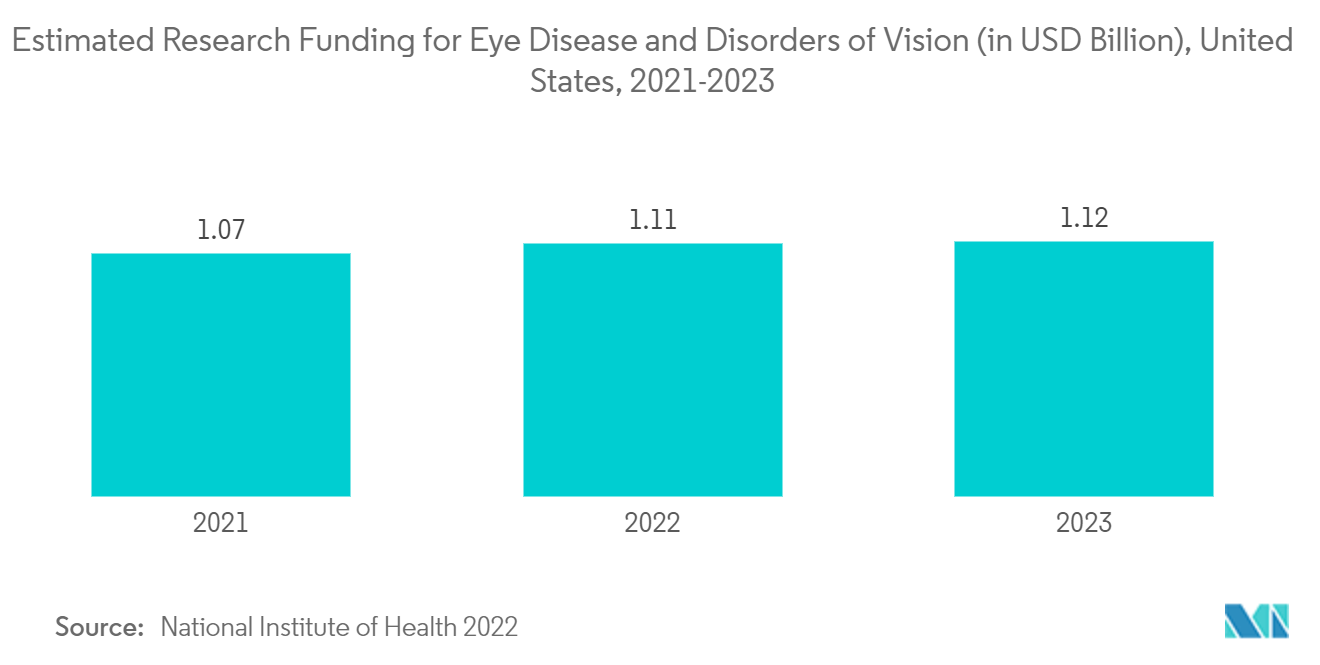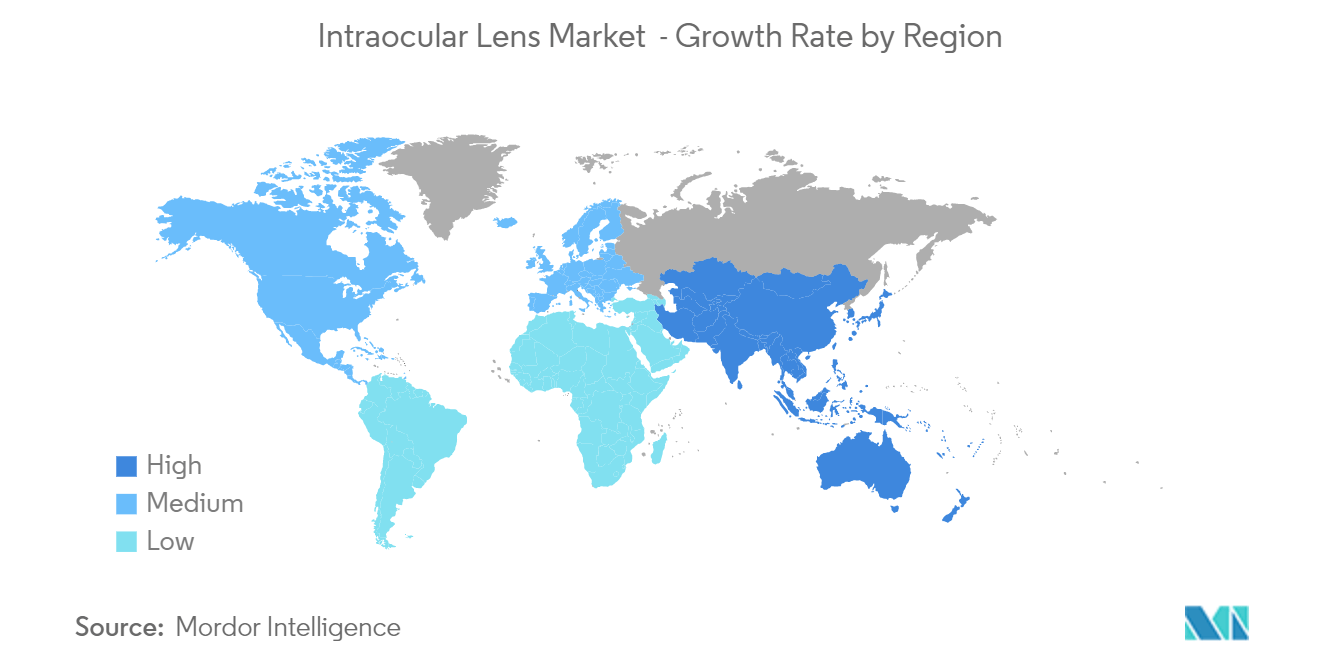Market Trends of Intraocular Lens Industry
Monofocal Intraocular Lens Segment is Expected to Hold a Significant Market Share Over the Forecast Period
Monofocal intraocular (IOL) is an intraocular lens with a fixed focus from one distance. The intraocular lens focuses on the light that enters through the cornea and pupil onto the retina. A mono-focal intraocular lens has equal power in all regions and a single zone of clear focus, producing excellent vision from a determined distance. Patients with cataracts in both eyes prefer mono-focal intraocular lenses so they can select one of the three focuses for both eyes (near focus, mid-distance, and distant focus). A mono-focal intraocular lens is the first choice for many, as it can provide the best image quality after surgery.
Factors such as increasing research studies and product launches by key market players are expected to boost market growth over the forecast period. The study published in the Scientific Reports in January 2022 mentioned that cataracts and blepharoptosis are common ophthalmic problems in older adults in Korea; the prevalence of blepharoptosis in middle-aged to older adults is over 10%, and cataract is 15%. Also, as per the 2022 Vision Index report, research supported the prevalence of myopia, with most respondents (81%) having trouble seeing objects at a distance and short-sightedness being the most common diagnosis for those who have had their eyesight examined by an optometrist (40%) in Australia in 2022.
Thus, the increasing prevalence of ophthalmic disease boosts market growth over the forecast period. The rising product launches have increased the adoption of monofocal intraocular lenses. For instance, in March 2022, Alcon launched Clareon Monofocal, Clareon PanOptix, and Clareon Vivity IOLs in the US. Similarly, in February 2021, Johnson & Johnson received FDA approval for the next-generation mono-focal intraocular lens, Tecnis Eyhance, and Tecnis Eyhance Toric II IOLs, for the treatment of cataract patients. Furthermore, the advancements in technology and increasing product approvals, along with partnerships and collaborations by key players, are also anticipated to drive segment growth. For instance, in September 2022, SIFI SpA launched Evolux, a novel extended monofocal IOL based on a hydrophobic material and a non-diffractive profile, designed to provide better intermediate vision and equivalent distance vision when compared to a standard monofocal IOL. Similarly, in July 2022, cuFocus, Inc. received FDA approval for its breakthrough IC-8 Apthera intraocular lens (IOL) for the treatment of cataracts. The Apthera IOL is the first and only non-toric extended depth of focus IOL approved for 82% of cataract patients who have as much as 1.5 diopters (D) of corneal astigmatism.
Therefore, owing to the rising eye issues, increase in product launches, and the high demand for mono-focal intraocular lenses, the segment is predicted to grow over the forecast period.

North America is Expected to Witness Significant Growth in the Market Over the Forecast Period
North America is expected to hold a significant market share in the studied market over the forecast period, owing to an increase in vision-related disorders, high adoption of new technologies and products in the healthcare sector, and a surge in demand for better healthcare facilities. For instance, according to the ophthalmology management's May 2022 update, there are 128 million presbyopes living in the United States. That number grows every day as millennials are turning 40 and become presbyopic. Thus, an increase in cases of presbyopia is likely to drive the intraocular lens market over the forecast period.
Additionally, the increasing prevalence of cataract issues, such as age-related cataracts and congenital cataracts, is anticipated to propel the market's growth over the forecast period. According to statistics published by NVision Centers, in 2022, it was found that about 12 million people aged 40 years and above were suffering from vision impairment in the United States. Similarly, as per the May 2021 update by Fighting Blindness Canada, 1.2 million Canadians were living with vision loss in 2021. As per the same source, 8 million Canadians had an eye condition that could result in blindness. Hence, the market is anticipated to develop due to the rising frequency of eye illnesses and the increased need for intraocular lenses.
Product launches by market players in the region are another factor in market growth. For instance, in February 2021, Johnson and Johnson received approval from the FDA for the TECNIS Eyhance and TECNIS Eyhance Toric II intraocular lens for the treatment of cataract patients in the United States. Similarly, in January 2021, Alcon launched the AcrySof IQ Vivity IOL (Vivity), a non-diffractive extended depth of focus intraocular lens (IOL), in the United States. Vivity is a one-of-its-kind, non-diffractive extended depth of focus IOL which employs Alcon's proprietary non-diffractive X-WAVE technology, which stretches and shifts light without splitting the lens. Such product launches provide innovative and advanced products, which are expected to increase market growth during the forecast period.
Thus, the occurrence of high cases of vision-related disorders, the presence of major market players, and an increase in product launches in the country are expected to drive the growth of the studied market in North America.


